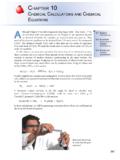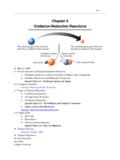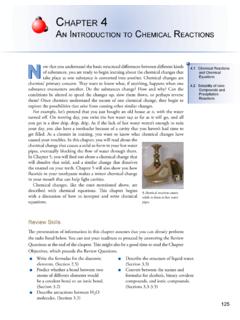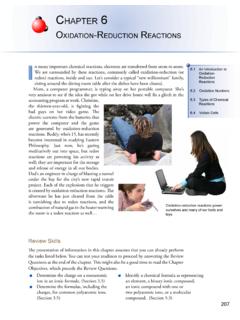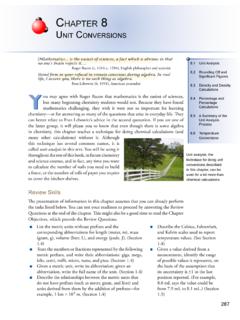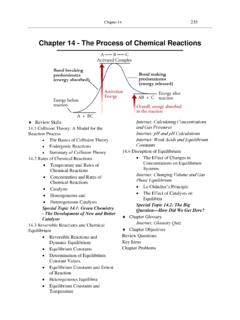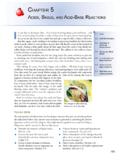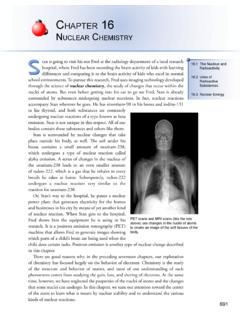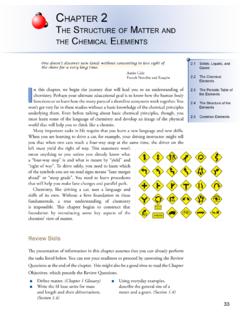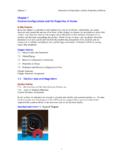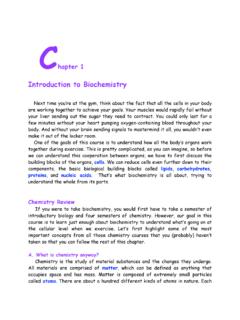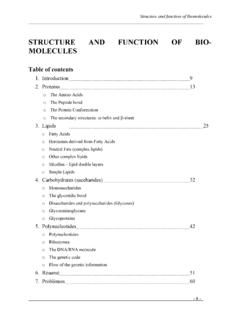Transcription of An Introduction to Chemistry
1 Chapter 3. Chemical Compounds An Introduction to Chemistry by Mark Bishop Chapter Map Elements, Compounds, and Mixtures Element: A substance that cannot be chemically converted into simpler substances; a substance in which all of the atoms have the same number of protons and therefore the same chemical characteristics. Compound: A substance that contains two or more elements, the atoms of these elements always combining in the same whole-number ratio. Mixture: A sample of matter that contains two or more pure substances (elements and compounds) and has variable composition. Classification of Matter Elements and Compounds Exhaust.
2 A Mixture Particle and Wave Nature All matter has both particle and wave character. The less massive the particle, the more important its wave character. The electron has a very low mass, low enough to have significant wave character. Covalent Bond Formation Covalent Bond Formation Increased negative charge between the two positive nuclei leads to increased +/- attraction and holds the atoms together. Covalent bond = a link between atoms due to the sharing of two electrons Molecule Molecule = an uncharged collection of atoms held together by covalent bonds. Two hydrogen atoms combine to form a hydrogen molecule, which is described with the formula H2.
3 Nonpolar Covalent Bond If the electrons are shared equally, there is a even distribution of the negative charge for the electrons in the bond, so there is no partial charges on the atoms. The bond is called a nonpolar covalent bond. Polar Covalent Bond If one atom in the bond attracts electrons more than the other atom, the electron negative charge shifts to that atom giving it a partial negative charge. The other atom loses negative charge giving it a partial positive charge. The bond is called a polar covalent bond. Ionic Bond The attraction between cation and anion. Atoms of nonmetallic elements often attract electrons so much more strongly than atoms of metallic elements that one or more electrons are transferred from the metallic atom (forming a positively charged particle or cation), to the nonmetallic atom (forming a negatively charged particle or anion).
4 For example, an uncharged chlorine atom can pull one electron from an uncharged sodium atom, yielding Cl and Na+. Ionic Bond Formation Sodium Chloride, NaCl, Structure Bond Types Types of Compounds All nonmetallic atoms usually leads to all covalent bonds, which from molecules. These compounds are called molecular compounds. Metal-nonmetal combinations usually lead to ionic bonds and ionic compounds. Classification of Compounds Summary Nonmetal-nonmetal combinations ( HCl). Covalent bonds Molecules Molecular Compound Metal-nonmetal combinations ( NaCl). Probably ionic bonds Alternating cations and anions in crystal structure Ionic compound Valence Electrons The valence electrons for each atom are the most important electrons in the formation of chemical bonds.
5 The number of valence electrons for the atoms of each element is equal to the element's A-group number on the periodic table. Covalent bonds often form to pair unpaired electrons and give the atoms of the elements other than hydrogen and boron eight valence electrons (an octet of valence electrons). Valence Electrons and A-Group Numbers Electron-Dot Symbols and Lewis Structures Electron-dot symbols show valence electrons. Nonbonding pairs of valence electrons are called lone pairs. Lewis Structures Lewis structures represent molecules using element symbols, lines for bonds, and dots for lone pairs. Most Common Bonding Patterns for Nonmetals Element # Bonds # lone pairs H 1 0.
6 C 4 0. N, P 3 1. O, S, Se 2 2. F, Cl, Br, I 1 3. Drawing Lewis Structures Chapter 12 describes procedure that allows you to draw Lewis structures for many different molecules. Many Lewis structures can be drawn by attempting to give each atom in a molecule its most common bonding pattern. Lewis Structure for Methane, CH4. Carbon atoms usually have 4. bonds and no lone pairs. Hydrogen atoms have 1 bond and no lone pairs. Tetrahedral Geometry Methane, CH4. Lewis Structure for Ammonia, NH3. Nitrogen atoms usually have 3 bonds and 1 lone pair. Hydrogen atoms have 1 bond and no lone pairs. Ammonia, NH3. Lewis Structure for Water, H2O.
7 Oxygen atoms usually have 2. bonds and 2 lone pairs. Hydrogen atoms have 1 bond and no lone pairs. Water, H2 O. Water Attractions Liquid Water Binary Covalent Common Names H2O, water NH3, ammonia CH4, methane C2H6, ethane C3H8, propane Naming Binary Covalent Compounds If the subscript for the first element is greater than one, indicate the subscript with a prefix. We do not write mono- on the first name. Leave the "a" off the end of the prefixes that end in "a" and the o off of mono- if they are placed in front of an element that begins with a vowel (oxygen or iodine). Follow the prefix with the name of the first element in the formula.
8 Naming Binary Covalent Compounds Write a prefix to indicate the subscript for the second element. Write the root of the name of the second symbol in the formula. Add -ide to the end of the name. Prefixes mon(o) hex(a). di hept(a). tri oct(a). tetr(a) non(a). pent(a) dec(a). Roots of Nonmetals H hydr- F fluor- C carb- Cl chlor- N nitr- Br brom- P phosph- I iod- O ox- S sulf- Se selen- Forms of Binary Covalent Names prefix(name of nonmetal) prefix(root of name of nonmetal)ide (for example, dinitrogen pentoxide). or (name of nonmetal) prefix(root of name of nonmetal)ide (for example, carbon dioxide). or (name of nonmetal) (root of nonmetal)ide (for example, hydrogen fluoride).
9 Writing Binary Covalent Formulas Write the symbols for the elements in the order mentioned in the name. Write subscripts indicated by the prefixes. If the first part of the name has no prefix, assume it is mono-. The Making of an Anion The Making of a Cation Monatomic Ions Monatomic Ion Names Monatomic Cations (name of metal). Groups 1, 2, and 3 metals Al3+, Zn2+, Cd2+, Ag+. (name of metal)(Roman numeral). All metallic cations not mentioned above Monatomic Anions (root of nonmetal name)ide Monatomic Anions Hydride H Fluoride F . Nitride N3 Chloride Cl . Phosphide P3 . Bromide Br . Oxide O2 . Sulfide S2 Iodide I.
10 Selenide Se2 . Sodium Chloride, NaCl, Structure CsCl and NH4Cl structure Polyatomic Ions Ion Name Ion Name NH4+ ammonium NO3 nitrate OH hydroxide SO42 sulfate CO32 carbonate C2H3O2 acetate PO43 phosphate Polyatomic Ions with Hydrogen HCO3 hydrogen carbonate HSO4 hydrogen sulfate HS hydrogen sulfide HPO42 hydrogen phosphate H2PO4 dihydrogen phosphate Recognizing Ionic Compounds Metal-nonmetal binary ionic compound Metal-polyatomic ion Ammonium-nonmetal or ammonium polyatomic ion Converting Ionic Formulas to Names Name (name of cation) (name of anion). Cation Names Metals with one name of metal possible charge (Al, Zn, Cd, and Groups 1, 2, 3).
